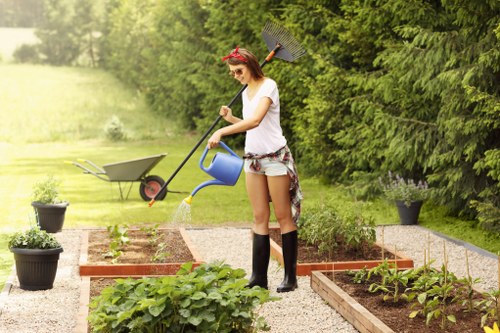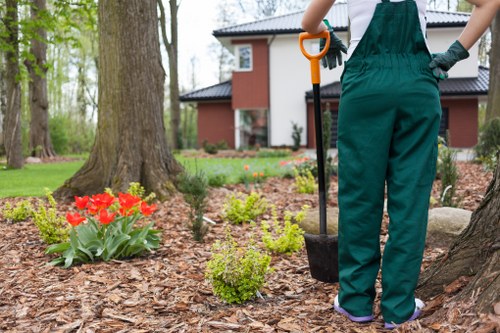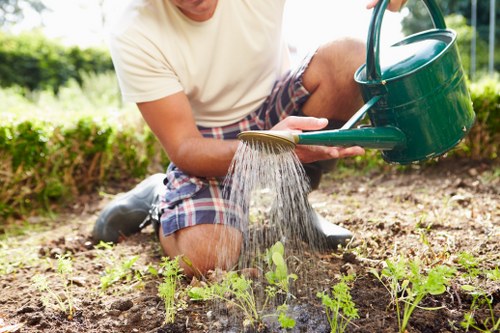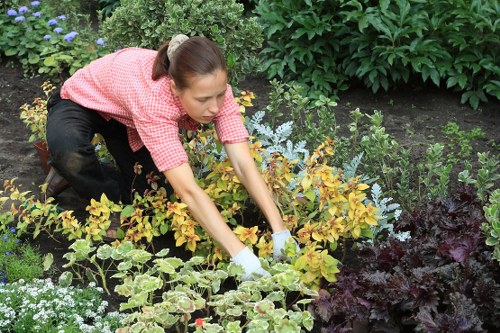Transforming Urban Spaces: Landscape Gardening in Holborn

Introduction to Landscape Gardening in Holborn
Holborn, situated in the heart of London, is renowned for its vibrant urban landscape and historical charm. As urbanization continues to expand, the demand for landscape gardening in Holborn has surged, offering residents and businesses alike opportunities to cultivate green, serene environments amidst the bustling city life.
Landscape gardening in Holborn is not just about enhancing aesthetic appeal; it's about creating sustainable and functional outdoor spaces that contribute to the well-being of the community. Whether you're looking to redesign your private garden, enhance your commercial property's exterior, or develop public green spaces, understanding the unique aspects of landscape gardening in this area is essential.
In this comprehensive guide, we'll explore the key elements of successful landscape gardening in Holborn, including plant selection, design principles, maintenance practices, and the benefits it brings to both individuals and the wider community.

Understanding the Urban Landscape of Holborn
Holborn's urban landscape is characterized by a mix of historical buildings, modern infrastructure, and limited green spaces. This unique setting poses both challenges and opportunities for landscape gardeners aiming to create lush environments within tight urban confines.
The area's rich history is reflected in its architecture, with many buildings dating back centuries. Incorporating traditional elements with contemporary design can create harmonious and timeless garden spaces. Additionally, the high population density means that efficient use of space is paramount, making vertical gardening and container plants popular choices.
Moreover, the local climate plays a significant role in determining suitable plant species. Holborn experiences a temperate climate with mild winters and warm summers, allowing for a wide variety of plants to thrive. Understanding these climatic conditions helps in selecting plants that are not only visually appealing but also resilient and low-maintenance.

Key Elements of Landscape Gardening in Holborn
Successful landscape gardening in Holborn hinges on several key elements:
1. Plant Selection
Choosing the right plants is crucial. Opt for native species that are well-adapted to the local climate, require less maintenance, and support local biodiversity. Consider a mix of perennials, shrubs, and trees to ensure year-round interest.
2. Sustainable Practices
Sustainability is at the forefront of modern gardening. Implementing practices such as rainwater harvesting, composting, and using organic fertilizers can create an eco-friendly garden that minimizes environmental impact.
3. Design and Layout
A thoughtful design enhances functionality and aesthetics. Incorporate elements like pathways, seating areas, and water features to create inviting spaces. Balance open spaces with planted areas to avoid overcrowding.
4. Maintenance
Regular maintenance ensures the garden remains healthy and beautiful. This includes pruning, weeding, mulching, and monitoring for pests and diseases. Efficient maintenance practices save time and resources in the long run.
5. Community Engagement
Engaging the local community fosters a sense of ownership and responsibility towards shared green spaces. Community gardens and collaborative projects can enhance social bonds and promote environmental stewardship.
- Native Plant Species
- Eco-friendly Gardening Techniques
- Innovative Design Solutions
- Consistent Maintenance Routines
- Community Involvement

Popular Plants for Holborn Gardens
Selecting plants that thrive in Holborn's climate and complement its urban setting is vital. Here are some popular choices:
1. Lavender
Lavender is cherished for its fragrant blooms and ability to attract pollinators. It's drought-resistant and requires minimal maintenance, making it ideal for urban gardens.
2. Boxwood
Boxwood is a versatile evergreen shrub commonly used for hedges and topiary. Its dense foliage provides structure and privacy in garden designs.
3. Hostas
Hostas offer lush foliage and come in a variety of colors and sizes. They thrive in shaded areas, making them perfect for gardens with limited sunlight.
4. Japanese Maple
Japanese Maples add elegance with their delicate leaves and striking colors. They are excellent focal points in garden layouts.
5. Grasses
Ornamental grasses provide movement and texture. They are low-maintenance and create a natural, flowing aesthetic.
- Lavender for fragrance and pollinators
- Boxwood for structure and privacy
- Hostas for lush, shaded areas
- Japanese Maple for elegance and color
- Ornamental Grasses for movement and texture

Sustainable Gardening Practices in Holborn
Embracing sustainability in landscape gardening not only benefits the environment but also enhances the longevity and resilience of gardens. Here are key sustainable practices to consider:
Rainwater Harvesting
Collecting and storing rainwater can significantly reduce water consumption. Use rain barrels or underground tanks to capture runoff, which can be used for irrigation during dry periods.
Composting
Composting organic waste transforms kitchen scraps and garden trimmings into nutrient-rich soil amendments. This reduces landfill waste and improves soil health.
Organic Fertilizers
Using organic fertilizers instead of chemical alternatives promotes healthy plant growth and minimizes the risk of soil and water contamination.
Native Plant Cultivation
Native plants are adapted to the local environment, requiring less water and maintenance. They also support local wildlife, including birds and beneficial insects.
Mulching
Applying mulch helps retain soil moisture, suppress weeds, and regulate soil temperature. It also adds a finished look to garden beds.
- Implementing efficient water management
- Reducing waste through composting
- Choosing eco-friendly fertilizers
- Planting native species
- Using mulch for moisture retention
Incorporating these sustainable practices into your landscape gardening routine ensures a greener, more resilient garden that thrives in Holborn's urban environment.
Benefits of Sustainable Gardening
Sustainable gardening offers numerous advantages, including:
- Reduced environmental footprint
- Lower maintenance costs
- Enhanced biodiversity
- Improved soil health
- Increased resilience to climate variations
Long-term Impact
By prioritizing sustainability, landscape gardeners in Holborn contribute to a healthier ecosystem and create gardens that endure for years to come.
Design Trends in Holborn Landscape Gardening
Landscape gardening in Holborn keeps pace with contemporary design trends while respecting the area's historical roots. Current trends include:
1. Vertical Gardens
With limited horizontal space, vertical gardens maximize the use of walls and vertical structures. They add greenery without encroaching on valuable ground space.
2. Sustainable Materials
Using recycled and eco-friendly materials for pathways, fences, and garden structures aligns with sustainable gardening principles.
3. Mixed-Use Spaces
Designing gardens that serve multiple functions, such as relaxation areas, dining spaces, and play zones, enhances usability and fosters community interaction.
4. Native and Drought-Resistant Plants
Emphasizing plants that require minimal water and maintenance supports sustainability and reduces the garden's ecological footprint.
5. Smart Irrigation Systems
Integrating technology into garden maintenance, such as smart irrigation systems, optimizes water usage and ensures efficient care.
- Maximizing vertical space
- Incorporating recycled materials
- Creating multifunctional areas
- Focusing on native flora
- Using technology for maintenance
Blending Tradition with Modernity
The best landscape gardens in Holborn blend traditional elements with modern design, creating timeless and functional outdoor spaces that cater to contemporary lifestyles.
Examples of Successful Designs
Local gardens showcase innovative designs that harmoniously integrate historical features with modern landscaping techniques, serving as inspirations for new projects.
Maintenance Tips for Holborn Gardens
Maintaining a beautiful landscape garden in Holborn requires consistent effort and attention to detail. Here are essential maintenance tips:
1. Regular Pruning
Pruning keeps plants healthy by removing dead or diseased branches, encouraging growth, and maintaining desired shapes.
2. Weeding
Frequent weeding prevents unwanted plants from competing with your desired flora for nutrients and water.
3. Soil Care
Testing and amending soil ensures optimal conditions for plant growth. Adding compost and organic matter improves soil structure and fertility.
4. Pest Management
Monitor plants for signs of pests and diseases. Use eco-friendly pest control methods to protect your garden without harming beneficial insects.
5. Seasonal Maintenance
Adapt your maintenance routine to the seasons. Prepare for winter by protecting sensitive plants and invigorate your garden in spring with new plantings.
- Maintain plant health through pruning
- Prevent weed growth
- Enhance soil fertility
- Control pests sustainably
- Adjust care for seasonal changes
Efficient Watering Practices
Implementing efficient watering techniques, such as drip irrigation and watering during early mornings or late evenings, conserves water and promotes healthy plant growth.
Tools and Equipment
Investing in quality gardening tools and equipment, such as pruning shears, wheelbarrows, and irrigation systems, can make maintenance tasks easier and more effective.
Proper maintenance ensures that your landscape garden in Holborn remains a thriving and attractive space for years to come.
Professional Assistance
For those seeking expertise, hiring professional landscape gardeners can provide tailored solutions and ensure high standards of garden care.
When to Seek Help
Consider professional services for large-scale projects, complex designs, or when specialized knowledge is required to address specific gardening challenges.
Benefits of Landscape Gardening in Holborn
Engaging in landscape gardening offers numerous benefits that extend beyond aesthetics:
1. Environmental Benefits
Green spaces contribute to improved air quality, reduced urban heat island effect, and enhanced biodiversity. Plants absorb carbon dioxide and release oxygen, purifying the air we breathe.
2. Health and Well-being
Access to green spaces promotes physical activity, reduces stress, and enhances mental health. Gardens offer a peaceful retreat from the hustle and bustle of city life.
3. Economic Advantages
Well-maintained gardens can increase property values and attract businesses. Commercial properties with appealing landscapes are more likely to draw customers and clients.
4. Social Impact
Gardens serve as communal spaces where individuals can gather, interact, and build stronger community ties. They foster a sense of belonging and collective responsibility.
5. Educational Opportunities
Gardens provide platforms for environmental education and awareness. They teach sustainable practices and encourage appreciation for nature among all age groups.
- Enhancing air quality and reducing pollution
- Promoting physical and mental health
- Boosting property values
- Fostering community interaction
- Offering educational resources
Long-term Sustainability
Investing in landscape gardening ensures the creation of lasting green spaces that contribute to the sustainability and resilience of urban environments.
Future Prospects
As awareness of environmental issues grows, the role of landscape gardening in creating sustainable cities like Holborn becomes increasingly important, paving the way for greener and healthier urban futures.
Ready to transform your outdoor space? Contact us today to start your landscape gardening journey in Holborn!

